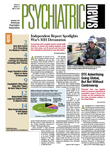Having a serious mental illness in the preceding 12 months significantly predicts reduced earning power, according to an analysis of the National Comorbidity Survey Replication (NCS-R).
Respondents with serious mental illness had 12-month earnings averaging $16,306 less than other respondents, after controlling for sociodemographic variables.
The total societal-level difference in earnings for people with mental illness was $193.2 billion. Of this total, more than 75 percent was due to reduced earnings among mentally ill people who did have some earnings; the remaining 25 percent was due to reduced probability of having any earnings at all.
The report was posted online on May 7 in AJP Advance and will appear in print in the June American Journal of Psychiatry.
“This is important because it is clear there is still an underappreciation among health policy planners who make decisions about allocation of resources for treatment of the importance of mental illness from a societal perspective,” study author Ronald Kessler, M.D., told Psychiatric News.
He noted that money devoted to care and treatment of such diseases as cancer and cardiovascular disease dwarfs that allocated to mental illness, despite the fact that from a public health perspective, mental illness exacts a larger toll.
Kessler said the study supports that by demonstrating the toll mental illness exacts in the workplace and in the economy.
“In our paper we only looked at those disorders that met criteria for serious and persistent mental illness,” Kessler said. “That [affects] roughly 6 or 8 percent of the American population. But the dollars lost in human capital are staggering.”
The NCS-R is a nationally representative survey of U.S. households that was administered from 2001 to 2003 and has provided data for numerous studies. In this latest report, the authors predicted personal earnings in the 12 months before interviews from information about 12-month and lifetime DSM-IV mental disorders among respondents aged 18 to 64, controlling for a host of variables including age at interview, gender, race, geographic region, and urbanicity.
In their analysis, the authors considered only those people who in the preceding 12 months had a “serious mental illness.” This was defined as nonaffective psychosis, bipolar disorder, severe major depression, and panic disorder, plus either a suicide attempt with serious lethality intent, an impulse-control disorder with repeated serious violence, or any other disorder that resulted in 30 or more days in which respondents could not carry out daily activities as usual in the 12 months before the interviews.
Serious mental illness was significantly associated with reduced earnings among both men and women, while associations with other 12-month and lifetime mental disorders were not statistically significant.
The societal-level effect of serious mental illness was estimated by projecting the individual-level effect to the 179.6 million persons aged 18 to 64 in the non-institutionalized civilian population of the United States, taking into consideration the estimated prevalence of serious mental illness and the estimated individual-level effect of serious mental illness on earnings. The estimated societal-level effect was $193.2 billion among the total population—$131.3 billion among men and $61.9 billion among women, according to the report.
Kessler said it is possible that discrimination accounts for some of the discrepancy in earning power, though that is unknown. But he said that his analysis was able to control for education, and the difference in earning power remained significant.
“These findings have implications for employers,” Kessler told Psychiatric News. “A lot of health care in America is driven by employers. From the perspective of the employer, we see that people with mental illness who are in the labor force miss more days and don't do as good a job.
“When you start thinking in those terms, one could make a case that investment in expansion of good-quality out-reach, detection, and treatment in the workplace is a human capital investment,” Kessler said.
“Individual and Societal Effects of Mental Disorders on Earnings in the United States: Results From the National Comorbidity Survey Replication” can be accessed at<http://ajp.psychiatryonline.org/pap.dtl>.▪
